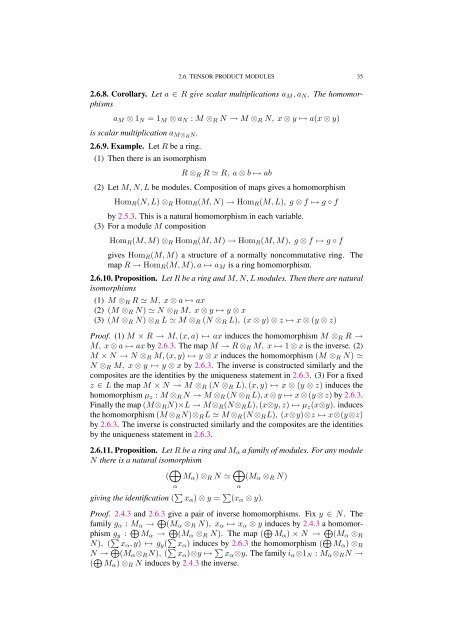Commutative algebra - Department of Mathematical Sciences - old ...
Commutative algebra - Department of Mathematical Sciences - old ...
Commutative algebra - Department of Mathematical Sciences - old ...
Create successful ePaper yourself
Turn your PDF publications into a flip-book with our unique Google optimized e-Paper software.
2.6. TENSOR PRODUCT MODULES 35<br />
2.6.8. Corollary. Let a ∈ R give scalar multiplications aM, aN. The homomorphisms<br />
aM ⊗ 1N = 1M ⊗ aN : M ⊗R N → M ⊗R N, x ⊗ y ↦→ a(x ⊗ y)<br />
is scalar multiplication aM⊗RN.<br />
2.6.9. Example. Let R be a ring.<br />
(1) Then there is an isomorphism<br />
R ⊗R R R, a ⊗ b ↦→ ab<br />
(2) Let M, N, L be modules. Composition <strong>of</strong> maps gives a homomorphism<br />
HomR(N, L) ⊗R HomR(M, N) → HomR(M, L), g ⊗ f ↦→ g ◦ f<br />
by 2.5.3. This is a natural homomorphism in each variable.<br />
(3) For a module M composition<br />
HomR(M, M) ⊗R HomR(M, M) → HomR(M, M), g ⊗ f ↦→ g ◦ f<br />
gives HomR(M, M) a structure <strong>of</strong> a normally noncommutative ring. The<br />
map R → HomR(M, M), a ↦→ aM is a ring homomorphism.<br />
2.6.10. Proposition. Let R be a ring and M, N, L modules. Then there are natural<br />
isomorphisms<br />
(1) M ⊗R R M, x ⊗ a ↦→ ax<br />
(2) (M ⊗R N) N ⊗R M, x ⊗ y ↦→ y ⊗ x<br />
(3) (M ⊗R N) ⊗R L M ⊗R (N ⊗R L), (x ⊗ y) ⊗ z ↦→ x ⊗ (y ⊗ z)<br />
Pro<strong>of</strong>. (1) M × R → M, (x, a) ↦→ ax induces the homomorphism M ⊗R R →<br />
M, x ⊗ a ↦→ ax by 2.6.3. The map M → R ⊗R M, x ↦→ 1 ⊗ x is the inverse. (2)<br />
M × N → N ⊗R M, (x, y) ↦→ y ⊗ x induces the homomorphism (M ⊗R N) <br />
N ⊗R M, x ⊗ y ↦→ y ⊗ x by 2.6.3. The inverse is constructed similarly and the<br />
composites are the identities by the uniqueness statement in 2.6.3. (3) For a fixed<br />
z ∈ L the map M × N → M ⊗R (N ⊗R L), (x, y) ↦→ x ⊗ (y ⊗ z) induces the<br />
homomorphism µz : M ⊗R N → M ⊗R (N ⊗R L), x ⊗ y ↦→ x ⊗ (y ⊗ z) by 2.6.3.<br />
Finally the map (M⊗RN)×L → M⊗R(N⊗RL), (x⊗y, z) ↦→ µz(x⊗y). induces<br />
the homomorphism (M ⊗RN)⊗RL M ⊗R(N ⊗RL), (x⊗y)⊗z ↦→ x⊗(y⊗z)<br />
by 2.6.3. The inverse is constructed similarly and the composites are the identities<br />
by the uniqueness statement in 2.6.3.<br />
2.6.11. Proposition. Let R be a ring and Mα a family <strong>of</strong> modules. For any module<br />
N there is a natural isomorphism<br />
( <br />
Mα) ⊗R N <br />
(Mα ⊗R N)<br />
α<br />
giving the identification ( xα) ⊗ y = (xα ⊗ y).<br />
Pro<strong>of</strong>. 2.4.3 and 2.6.3 give a pair <strong>of</strong> inverse homomorphisms. Fix y ∈ N. The<br />
family gα : Mα → (Mα ⊗R N), xα ↦→ xα ⊗ y induces by 2.4.3 a homomorphism<br />
gy : Mα → (Mα ⊗R N). The map ( Mα) × N → (Mα ⊗R<br />
N), ( xα, y) ↦→ gy( xα) induces by 2.6.3 the homomorphism ( Mα) ⊗R<br />
N → (Mα⊗RN), ( xα)⊗y ↦→ xα⊗y. The family iα⊗1N : Mα⊗RN →<br />
( Mα) ⊗R N induces by 2.4.3 the inverse.<br />
α
















